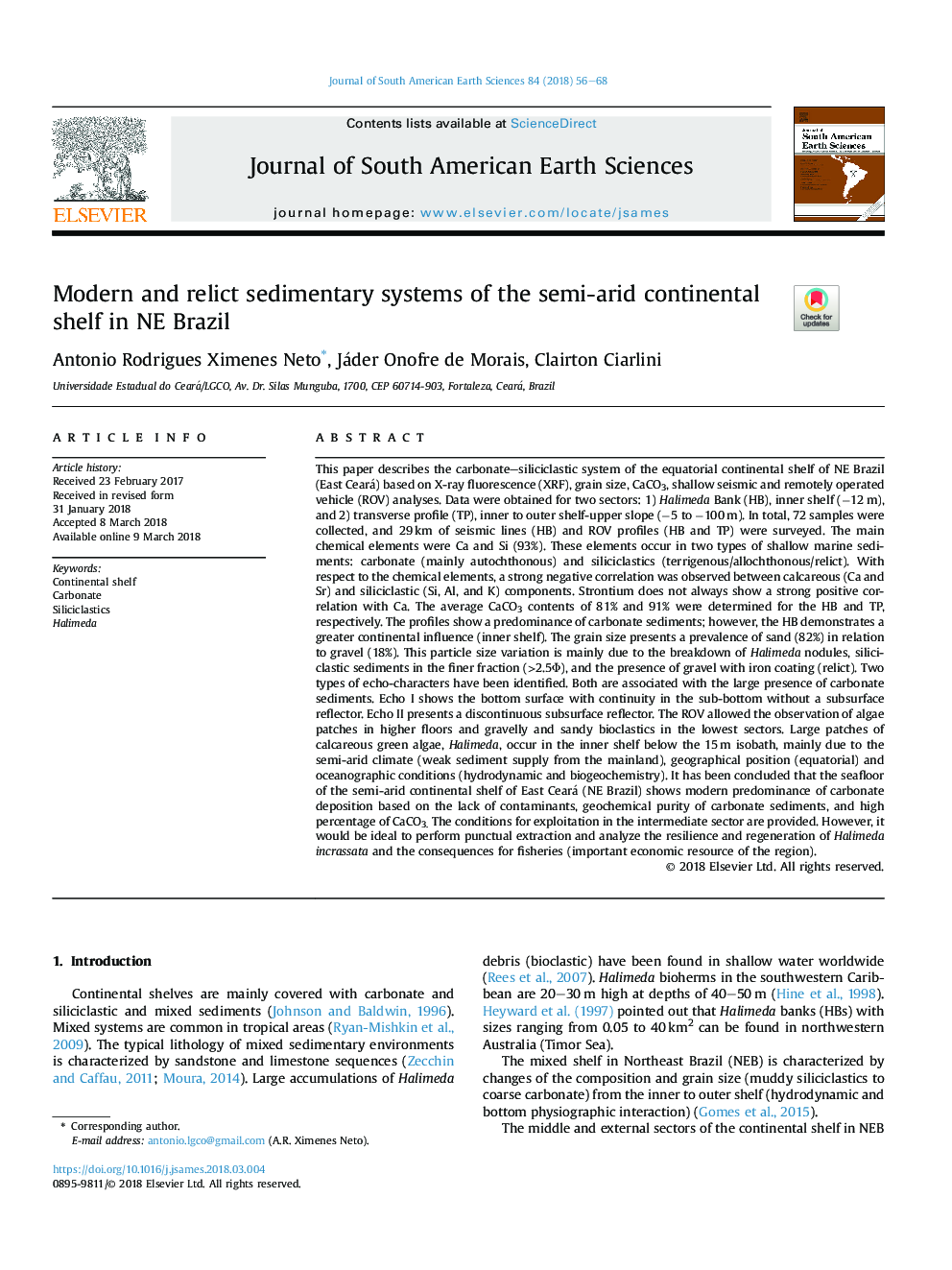| کد مقاله | کد نشریه | سال انتشار | مقاله انگلیسی | نسخه تمام متن |
|---|---|---|---|---|
| 8907652 | 1635126 | 2018 | 13 صفحه PDF | دانلود رایگان |
عنوان انگلیسی مقاله ISI
Modern and relict sedimentary systems of the semi-arid continental shelf in NE Brazil
دانلود مقاله + سفارش ترجمه
دانلود مقاله ISI انگلیسی
رایگان برای ایرانیان
کلمات کلیدی
موضوعات مرتبط
مهندسی و علوم پایه
علوم زمین و سیارات
علوم زمین و سیاره ای (عمومی)
پیش نمایش صفحه اول مقاله

چکیده انگلیسی
This paper describes the carbonate-siliciclastic system of the equatorial continental shelf of NE Brazil (East Ceará) based on X-ray fluorescence (XRF), grain size, CaCO3, shallow seismic and remotely operated vehicle (ROV) analyses. Data were obtained for two sectors: 1) Halimeda Bank (HB), inner shelf (â12â¯m), and 2) transverse profile (TP), inner to outer shelf-upper slope (â5 to â100â¯m). In total, 72 samples were collected, and 29â¯km of seismic lines (HB) and ROV profiles (HB and TP) were surveyed. The main chemical elements were Ca and Si (93%). These elements occur in two types of shallow marine sediments: carbonate (mainly autochthonous) and siliciclastics (terrigenous/allochthonous/relict). With respect to the chemical elements, a strong negative correlation was observed between calcareous (Ca and Sr) and siliciclastic (Si, Al, and K) components. Strontium does not always show a strong positive correlation with Ca. The average CaCO3 contents of 81% and 91% were determined for the HB and TP, respectively. The profiles show a predominance of carbonate sediments; however, the HB demonstrates a greater continental influence (inner shelf). The grain size presents a prevalence of sand (82%) in relation to gravel (18%). This particle size variation is mainly due to the breakdown of Halimeda nodules, siliciclastic sediments in the finer fraction (>2.5Φ), and the presence of gravel with iron coating (relict). Two types of echo-characters have been identified. Both are associated with the large presence of carbonate sediments. Echo I shows the bottom surface with continuity in the sub-bottom without a subsurface reflector. Echo II presents a discontinuous subsurface reflector. The ROV allowed the observation of algae patches in higher floors and gravelly and sandy bioclastics in the lowest sectors. Large patches of calcareous green algae, Halimeda, occur in the inner shelf below the 15â¯m isobath, mainly due to the semi-arid climate (weak sediment supply from the mainland), geographical position (equatorial) and oceanographic conditions (hydrodynamic and biogeochemistry). It has been concluded that the seafloor of the semi-arid continental shelf of East Ceará (NE Brazil) shows modern predominance of carbonate deposition based on the lack of contaminants, geochemical purity of carbonate sediments, and high percentage of CaCO3. The conditions for exploitation in the intermediate sector are provided. However, it would be ideal to perform punctual extraction and analyze the resilience and regeneration of Halimeda incrassata and the consequences for fisheries (important economic resource of the region).
ناشر
Database: Elsevier - ScienceDirect (ساینس دایرکت)
Journal: Journal of South American Earth Sciences - Volume 84, July 2018, Pages 56-68
Journal: Journal of South American Earth Sciences - Volume 84, July 2018, Pages 56-68
نویسندگان
Antonio Rodrigues Ximenes Neto, Jáder Onofre de Morais, Clairton Ciarlini,